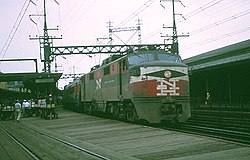
Back New York, New Haven and Hartford Railroad German New York, New Haven and Hartford Railroad Estonian New York, New Haven and Hartford Railroad French ニューヨーク・ニューヘイブン・アンド・ハートフォード鉄道 Japanese New York, New Haven and Hartford Railroad Dutch
 | |
 System map, 1918 (not including its temporary acquisition of the NY&OW) | |
 A New Haven Railroad train in Bridgeport, Connecticut in 1962 | |
| Overview | |
|---|---|
| Headquarters | New Haven, Connecticut |
| Reporting mark | NH |
| Locale | |
| Dates of operation | July 24, 1872–December 31, 1968 |
| Successor | Penn Central Transportation Company |
| Technical | |
| Track gauge | 4 ft 8+1⁄2 in (1,435 mm) standard gauge |
| Length | 2,133 miles (3,433 kilometers) |

The New York, New Haven and Hartford Railroad (reporting mark NH), commonly known as The Consolidated, or simply as the New Haven, was a railroad that operated principally in the New England region of the United States from 1872 to December 31, 1968. Founded by the merger of the New York and New Haven and Hartford and New Haven railroads, the company had near-total dominance of railroad traffic in Southern New England for the first half of the 20th century.
Beginning in the 1890s and accelerating in 1903, New York banker J. P. Morgan sought to monopolize New England transportation by arranging the NH's acquisition of 50 companies, including other railroads and steamship lines, and building a network of electrified trolley lines that provided interurban transportation for all of southern New England. By 1912, the New Haven operated more than 2,000 miles (3,200 km) of track, with 120,000 employees, and practically monopolized traffic in a wide swath from Boston to New York City.
This quest for monopoly angered Progressive Era reformers, alienated public opinion, raised the cost of acquiring other companies and increased the railroad's construction costs. The company's debt soared from $14 million in 1903 to $242 million in 1913, while the advent of automobiles, trucks and buses reduced its profits. Also in 1913, the federal government filed an antitrust lawsuit that forced the NH to divest its trolley systems.[1]
The line became bankrupt in 1935. It emerged from bankruptcy, albeit reduced in scope, in 1947, only to go bankrupt again in 1961. In 1969, its rail assets were merged with the Penn Central system,[2] formed a year earlier by the merger of the New York Central Railroad and Pennsylvania Railroad. Already a poorly conceived merger, Penn Central went bankrupt in 1970, becoming the largest U.S. bankruptcy until the Enron Corporation superseded it in 2001. The remnants of the system now comprise Metro-North Railroad's New Haven Line, much of the northern leg of Amtrak's Northeast Corridor, Connecticut's Shore Line East and Hartford Line, parts of the MBTA, and numerous freight operators such as CSX and the Providence and Worcester Railroad. The majority of the surviving system is now owned publicly by the states of Connecticut, Rhode Island, and Massachusetts, with other surviving segments owned by freight railroads; many abandoned lines have been converted into rail trails.
- ^ Vincent P. Carosso (1987). The Morgans: Private International Bankers, 1854–1913. Harvard UP. pp. 607–10. ISBN 9780674587298.
- ^ John L. Weller, The New Haven Railroad: its rise and fall (1969)
© MMXXIII Rich X Search. We shall prevail. All rights reserved. Rich X Search